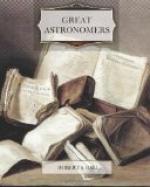Flamsteed had the misfortune, in the latter part of his life, to become estranged from his most eminent scientific contemporaries. He had supplied Newton with places of the moon, at the urgent solicitation of the author of the “Principia,” in order that the lunar theory should be carefully compared with observation. But Flamsteed appears to have thought that in Newton’s further request for similar information, he appeared to be demanding as a right that which Flamsteed considered he was only called upon to render as a favour. A considerable dispute grew out of this matter, and there are many letters and documents, bearing on the difficulties which subsequently arose, that are not, perhaps, very creditable to either party.
Notwithstanding his feeble constitution, Flamsteed lived to the age of seventy-three, his death occurring on the last day of the year 1719.
HALLEY.
Isaac Newton was just fourteen years of age when the birth of Edmund Halley, who was destined in after years to become Newton’s warmly attached friend, and one of his most illustrious scientific contemporaries, took place. There can be little doubt that the fame as an astronomer which Halley ultimately acquired, great as it certainly was, would have been even greater still had it not been somewhat impaired by the misfortune that he had to shine in the same sky as that which was illumined by the unparalleled genius of Newton.
Edmund Halley was born at Haggerston, in the Parish of St. Leonard’s, Shoreditch, on October 29th, 1656. His father, who bore the same name as his famous son, was a soap-boiler in Winchester Street, London, and he had conducted his business with such success that he accumulated an ample fortune. I have been unable to obtain more than a very few particulars with respect to the early life of the future astronomer. It would, however, appear that from boyhood he showed considerable aptitude for the acquisition of various kinds of learning, and he also had some capacity for mechanical invention. Halley seems to have received a sound education at St. Paul’s School, then under the care of Dr. Thomas Gale.




